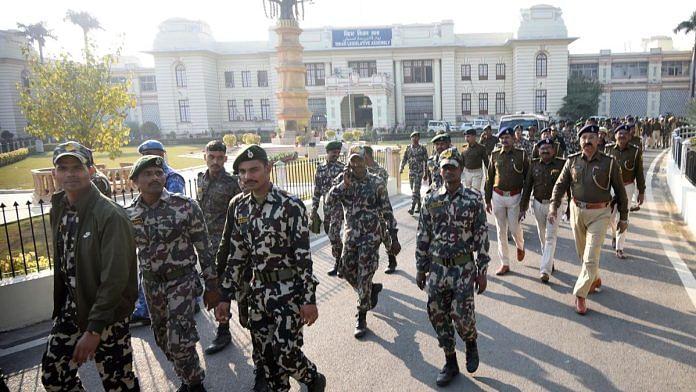


New Delhi: The nationwide police-to-population ratio indicates that, on average, one police personnel—combining civil and district armed police—served 831 individuals as of January 2023. However, in Bihar, this ratio stood at 1:1,522, according to the India Justice Report 2025 released Tuesday.
The national average remained unchanged from 2022. Nonetheless, the report highlighted that in seven states and Union territories—Assam, Bihar, Dadra & Nagar Haveli and Daman & Diu, Gujarat, Madhya Pradesh, Odisha, Rajasthan, and West Bengal—one police personnel continued to serve over a thousand individuals.
The report also noted that, between 2017 and 2023, both urban and rural police stations have been required to serve growing populations across increasingly vast areas.
“On average, a rural police station which served 83,000 people in January 2017 now caters to nearly one lakh in 2023. In urban areas, the rise has been from 74,000 to over 93,000. Simultaneously, the number of rural police stations has decreased by 735, whereas the number of urban stations has increased by 193,” the report stated.
Former IPS officer and security secretary Yashovardhan Jha Azad attributed these figures to inadequate budgetary allocation.
“State governments today, quite sadly, fail to allocate appropriate budgets for the police. This trend is observable across various states,” he told ThePrint. “The tendency is always to rely on the Centre, even for basic law and order matters. As a result, there is demand for central forces, for infrastructure, for modernisation, for establishing police stations, and for recruitment. It is very unfortunate.”
While the average expenditure per police personnel rose from Rs 823 in 2015–16 to Rs 1,275 by 2022–23, 90 percent of the police budget is reserved for recurring expenses such as salaries, pensions, and general operational costs like vehicle maintenance. Only 1.25 percent of the budget is allocated to training, the report added.
It also expressed concern over the underutilisation of modernisation funds, stating that in 2021–22, most states utilised less than 50 percent of the total allocated amount.
The report is a collaborative effort involving several organisations, including the Centre for Social Justice (IDEAL), Common Cause, Commonwealth Human Rights Initiative (CHRI), Daksh, TISS-Prayas, Vidhi Centre for Legal Policy, and How India Lives, the data partner for the India Justice Report.
Also Read: Just 8% of country’s police officers are women, 12% in IPS, finds India Justice Report 2025
The report assessed various parameters to evaluate states’ performance in justice delivery. For example, it noted that Karnataka is the only state that meets its quotas for Scheduled Castes (SCs), Scheduled Tribes (STs), and Other Backward Classes (OBCs) in both the police and the judiciary.
Each state has its own quotas for SCs, STs, and OBCs. Additionally, the report observed that fulfilling SC quotas within the police lags behind the achievement of ST and OBC quotas.
At the officer level, only five states—Goa, Gujarat, Himachal Pradesh, Karnataka, and Manipur—met their SC targets, compared with seven states that met ST targets and nine that met OBC targets.
The data regarding the police is current up to January 2023, and captures the numbers of SCs, STs and OBCs only present in six ranks—Deputy Superintendent, Inspector, Sub-Inspector, Assistant Sub-Inspector, Head Constable, and Constable.
Azad emphasised the importance of increased representation from SC/ST/OBC communities within the police force.
“I would welcome more SCs and STs in the police because in those specific areas, they might have a better understanding of the local situation. It genuinely helps,” he told ThePrint.
However, he did not believe that there is any deliberate “intent” behind the failure to fill SC/ST/OBC quotas.
In the judiciary, while state-specific data on caste diversity in high courts remains unavailable, the report cited parliamentary responses to reveal that of the 698 high court judges appointed since 2018, 22 were from SCs, 15 were from STs, and 87 were from OBCs.
The data for judges is current up to February–March 2025.
Only five percent of judges in the district judiciary belong to STs, while 14 percent are from SCs, according to the report.
Commenting on this representation, senior advocate Indira Jaising noted that most states do provide reservations for SC and ST communities, as well as for women, in the subordinate judiciary—and this is reflected in the statistics.
“On the other hand, no such reservations exist at the high court level, all in the name of ‘merit’ and the ‘independence of constitutional courts’. In truth, privilege begets privilege, and Brahmins dominate the higher courts,” she asserted.
(Edited by Radifah Kabir)
Also Read: UP, Bihar, Maharashtra make up 42% of all undertrials in India, shows India Justice Report 2025





